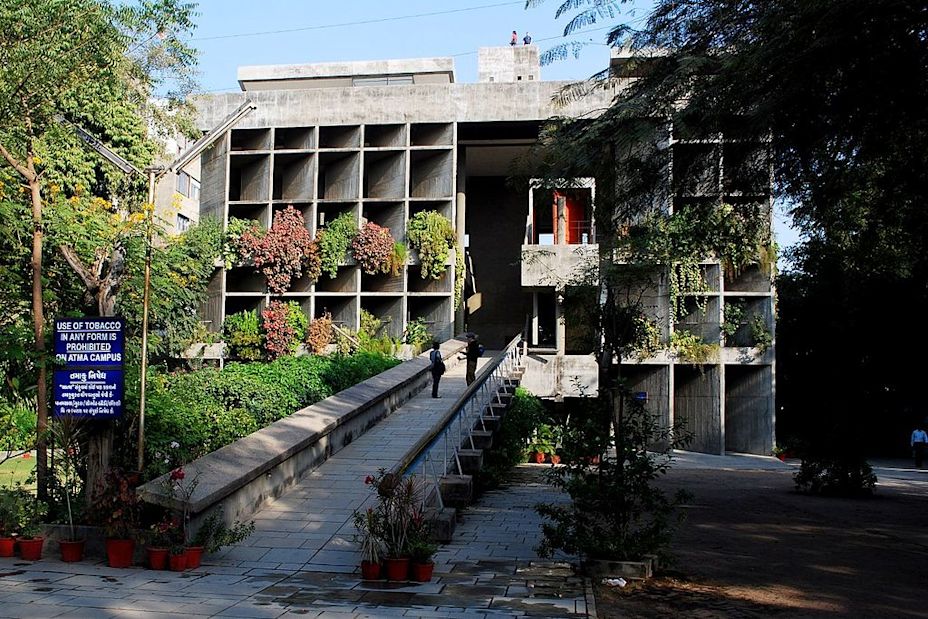Balkrishna Doshi and Le Corbusier: A collaboration that changed architecture.
When the young architect Balkrishna Doshi, who was intimately familiar with Indian sensibilities and climate, collaborated with Le Corbusier, the leading force behind Brutalist architecture, they built a bridge between Eastern traditions and Western modernity, creating a milestone in architectural history.

Charles-Édouard Jeanneret, known as Le Corbusier, believed that design should be utilitarian or functional. He rejected the ornamentation of Art Nouveau because it was not functional, and instead turned to the streamlined forms of industrial machines. This shift paved the way for a modern architectural movement and made him one of the most important representatives of Brutalism in the 1950s and 1960s, characterized by simple, streamlined forms and exposed concrete structures.
Balkrishna Doshi, who admired Le Corbusier as both a guru and an acrobat, shared the devotion to functional design. Doshi played a key role in merging traditional Indian architectural principles with international modern design. This fusion has redefined the landscape of Indian cities and continues to inspire architects around the world today.
Encounters in Paris
After 1947, as independent India coped with rapid urbanization, social change, and the transition to a market economy while simultaneously seeking a national identity, modernism became the dominant design approach in the architectural landscape. For Le Corbusier, the commission to design the master plan for Chandigarh, the new capital of Punjab, on behalf of the Indian leadership, was an opportunity to make Chandigarh a symbol of modernity.
Despite the popularity of modernism, some architects preferred local materials, indigenous craftsmanship, and pre-colonial motifs. Doshi, a pioneer of modern architecture in India, advocated for the fusion of Indian traditions with Western modernity.
After hearing about Le Corbusier’s commissions in India, Doshi began working in his Paris studio in 1951. Doshi’s knowledge of India’s geographic diversity, its culture, and the various weather events, such as monsoons and heat waves, influenced the planning of the new city, residential areas, and open spaces. After returning to India in 1954, Doshi helped supervise some of Le Corbusier’s projects in Chandigarh and Ahmedabad.
These projects illustrate the legacy of the collaboration between Doshi and Le Corbusier, which advanced modernist architecture in India and set a precedent for integrating local environments and cultural contexts into design. Doshi drew invaluable lessons from this experience, which later influenced his own practice. He integrated the ideas of European modernism with local cultural and climatic conditions, marking the beginnings of architectural modernism in India.
Joint Projects and Architectural Legacy

Chandigarh was a remarkable project that stands as proof of their partnership. Other projects that were part of the collaboration included the Punjab High Court and the Villa Sarabhai. In Ahmedabad, they jointly created iconic buildings such as the Institute of Indology, which established Le Corbusier’s successful career. The concrete structure, built on a platform, is an example of Brutalism, but adapts to the hot climate of Gujarat by using perforated facades for air circulation and sunshades for protection from the sun.
Doshi’s expertise in Indian culture and design was crucial for shaping these landmarks, which are both innovative and culturally relevant. He combined modernist principles with the local context, creating harmonious designs that meet the cultural and climatic needs of India.
Design Philosophy and Urban Innovations

The design philosophy of Doshi and Le Corbusier emphasized creating functional and socially responsible architecture that combines sustainability and innovation. Among the most important urban planning advances they advocated were modular construction, open floor plans, and the integration of green spaces. These elements aimed to improve quality of life and promote ecological sustainability.
A key aspect of the design philosophy of Doshi and Le Corbusier was the emphasis on human scale, ensuring that the urban environment is accessible, involves people, and responds to their needs. They believed that architecture should promote social justice by considering the diverse socioeconomic circumstances of communities.
With an approach deeply rooted in the principles of sustainable development, including the integration of green spaces and design strategies that use local materials, they helped shape a vision for sustainable architecture and construction that continues to influence designers today.
Impact on Indian Architecture and Beyond
Doshi’s professional career under the mentorship of Le Corbusier created a solid foundation for understanding space, form, light, and ventilation, which he adapted to the climatic and cultural conditions of India. This synthesis of modernist principles and local sensitivity is evident in Doshi’s projects, especially in his designs for the CEPT University.
The architectural language developed through this collaboration was further expanded by Doshi’s founding of the School of Architecture at CEPT University, which is central to architectural education in India. In addition to the innovative architectural approaches that emerged from this collaboration, Doshi’s philosophy as an educator promoted practical engagement and a multidisciplinary approach, and continues to shape the discourse on urbanism and sustainability.
Cultural Exchange and Mutual Influence
Doshi’s first projects in India reflect the influence of Le Corbusier’s modernism, especially Brutalism, which is highlighted by bold colors, streamlined forms, and raw concrete. However, as Doshi’s design philosophy evolved, he adapted these principles to Indian conditions, creating more accessible spaces and using local materials.
It is important to mention that Le Corbusier’s influence went beyond architectural style and inspired Doshi to adopt a broader philosophical approach to architecture. This included prioritizing space, form, and the natural environment while remaining sensitive to cultural and climatic contexts.
Le Corbusier also learned from Doshi, especially regarding the adaptation of modernist principles to the unique culture, climate, and society of India. Doshi’s deep understanding of Indian culture helped Le Corbusier incorporate modernist and Brutalist elements into his plans while making them more culturally relevant and responsive to local needs.
Legacy and Recognition

The collaboration between Balkrishna Doshi and Le Corbusier transcended geographical boundaries and cultural differences, earning numerous awards and recognitions, including prestigious prizes and the designation of the Capitol Complex in Chandigarh as a UNESCO World Heritage Site.
Doshi was honored in 2018 with the Pritzker Architecture Prize, making him the first Indian recipient of this “Nobel Prize of Architecture.” He also received the Gold Medal of the Royal Institute of British Architects in 2022 and was named an Officer of the Order of Arts and Letters by the French government in 2011 for his contributions to art and architecture. He was also awarded the Padma Bhushan in 2020 and received the Padma Vibhushan posthumously, India’s second-highest civilian honor.
Le Corbusier received the Grand Officer of the Legion of Honor in 1964, one of France’s highest honors. In 1961, he received the Frank P. Brown Medal of the Franklin Institute for his contributions to science and technology and the AIA Gold Medal of the American Institute of Architects. In addition, he received the Royal Gold Medal of the Royal Institute of British Architects in 1953, honoring his lifetime achievements in architecture.
Continued Relevance and Future Perspectives
The principles of Doshi and Le Corbusier offer solutions to the architectural and urban challenges of our time. Their approach to urbanization, which combines modernist techniques with local sensitivity and prioritizes sustainability and social equality, can help today’s architects create inspiring structures for all.
Opportunities for future collaborations inspired by their work include the incorporation of passive design strategies and green infrastructure, human-centered architecture, and socially inclusive designs. Their work also inspires innovative housing solutions and community-oriented projects to address the challenges of urbanization.
The collaboration between Doshi and Le Corbusier has established proven principles for today’s architects to create resilient, just, and sustainably built environments that meet evolving societal needs and contribute to a more sustainable and inclusive future.



